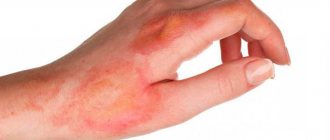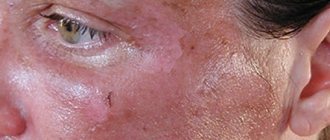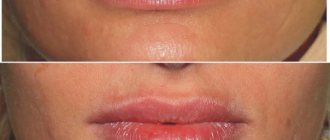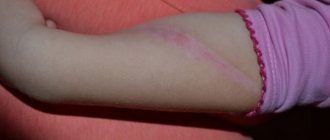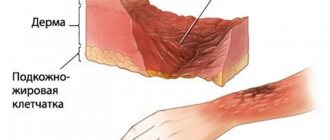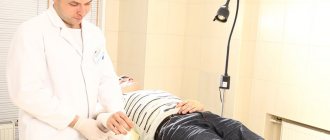Types of chemical burns
Chemical burns are divided into several categories based on the main parameter - the type of substance that caused the tissue damage.
- Acidic - occur when acids come into contact with the skin and are accompanied by the coagulation of protein in the blood. During the process of destruction, the protein turns into a crust, which serves as a natural protection for tissues from deep penetration of acid. Burns of this type are most often not very deep.
- Alkaline - occur due to contact with the skin of ammonia, quicklime, caustic soda, etc. Alkali strongly and deeply corrodes tissue, so the damage is extensive. Alkaline burns are difficult and slow to heal even with proper treatment.
- Phosphorus burns - these burns are very dangerous because the substance begins to burn upon contact with the skin. As a result, deep wounds are formed that require specific treatment.
- Burns caused by contact with heavy metal salts on the skin - they most often destroy only the top layer of skin, and are the least dangerous of all chemical burns.
If you are not sure what substance caused the burn, you should try to obtain a sample of it, place it in a sealed container and give it to the doctors - this will help to correctly determine the cause of tissue damage and prescribe the correct treatment.
Severity
There are 4 degrees that describe the severity and depth of tissue damage upon contact with chemically active substances:
- I degree - only the outermost layer of skin (epidermis) is damaged. A first-degree burn is characterized by slight redness of the tissue, mild pain, and slight swelling. Such burns are relatively easy and quick to treat, and usually do not leave scars after complete healing. After about 5-7 days, not a trace remains of the first-degree burn.
- II degree - accompanied by damage to the deeper layers underlying the epidermis. The burned area becomes very red, and bubbles with a colorless liquid appear inside. Second degree burns take approximately 2-3 weeks to heal.
- III degree - with such burns, all layers of the skin can be affected, the damage often reaches the subcutaneous layer of fat. The affected areas become red and blisters with clear or bloody fluid form. Third-degree burns are often accompanied by sensory loss—that is, pain in the burned area itself is not felt. Healing takes from 1 to several months; a scar remains at the burn site.
- IV degree – all tissues down to the bones (skin, muscles, tendons) are affected. The most severe degree, such burns are practically untreatable.
Chemical burns are dangerous because in many cases they immediately cause severe damage, which is classified as III and IV degrees.
Modern headbands
There are a huge number of new dressings that can be used at home to promote rapid healing. The main difference from a regular bandage is that they create a favorable microclimate in the wound. After all, if the affected area of the skin dries completely, it will not speed up healing.
Branolind N with Peruvian balsam
The patch has a specific odor; it is used for wounds of 1-2 degrees; it cannot be used for necrotic damage. You can change the bandage once every two days. A contraindication is an allergic reaction to the patch, manifested by redness and swelling.
Hydrocoll
Gel dressing, which is used for 1-2 degree burns. The package contains a 15x15 cm bandage that can be adjusted to the size of the wound. The bandage should cover the damaged area by 1-2 cm.
Silkoplast Comfort IT-Burn
Used for grade 1-2 wounds, relieves pain and promotes rapid healing.
Consequences
If the burn was caused by an acid or alkali, a crust forms in its place, which has its own name - a scab.
Alkalies in contact with skin are much more dangerous than acids, because... they quickly penetrate into the deep layers of tissue, causing serious damage.
- If the burn was caused by alkali, the color of the scab is whitish, without clear boundaries, with an imperceptible transition to adjacent healthy tissue. The texture of the scab is soft and loose; it hardens much later.
- When exposed to acid, the scab looks different - from dense, hard and dry. The border is clearly defined, the transition to healthy areas of the skin is visible to the naked eye. Typically, such injuries are superficial, which speeds up recovery.
The color of the tissue in the affected area depends on the type of chemical:
- When sulfuric acid comes into contact with the skin, the burn is initially white, then turns gray or brown.
- When exposed to nitrogen acid, the burn will be light yellow, with a greenish or brown tint.
- When skin comes into contact with hydrochloric acid, a yellow burn is formed;
- Acetic acid leaves off-white burns when it comes into contact with the skin;
- After carbolic acid, white traces remain, which subsequently become brown;
- Concentrated hydrogen peroxide leaves dirty-gray burns.
It is useful to study and remember the differences in burns by color so that in a critical situation you can quickly determine the type of composition that burned the skin. This will help minimize harm or even save lives.
When chemicals get on the skin, their effect continues for some time after contact has been stopped (the wound is washed, a bandage is applied).
This is due to the peculiarities of the functioning of our tissues - the absorption of the substance does not stop instantly, which makes it much more difficult to determine the degree of the burn.
Sometimes the substance continues to act for several hours or even days - so it is very difficult to immediately draw conclusions about the depth of the damage. As a rule, it is possible to accurately determine the extent of the burn only 1-1.5 weeks after the injury - by this time the scab begins to suppurate, which is one of the parameters when determining the depth of the damage.
The severity of a burn from contact with chemicals depends on two key characteristics - depth and area. Chemical burns themselves are usually deep, and if they are also large, this aggravates the situation.
What is an acid?
From a chemical point of view, an acid is a substance that contains hydrogen atoms (which can be replaced by metal atoms) and an acidic residue.
Acetic acid, malic acid, citric acid, ascorbic acid (vitamin C), oxalic acid and some other acids are familiar to us in everyday life. This is the so-called organic acids, that is, synthesized by living organisms.
In the chemical industry there are inorganic acidic compounds, for example, the well-known sulfuric (H2SO4) or hydrochloric (HC1) acid.
All acids have an irritating effect (to one degree or another) on the human body.
How to provide first aid for a chemical burn
The first thing to do when chemicals come into contact with your skin is to remove them immediately and do everything possible to reduce the concentration of chemical residues on the surface of the tissue. This is done by rinsing with plenty of running water and cooling the burned areas.
Procedure for chemical burns:
- Immediately remove everything that may have gotten chemicals on it - clothes, accessories, underwear. The composition can quickly saturate the fabric or flow onto the skin along metal elements, which will increase the affected area.
- Place the area where the chemicals come into contact with cold running water for at least 20 minutes (the longer the better). You should not try to remove the chemical from the skin with napkins, cloth or any other available means - any rubbing movement will only increase the penetration of the dangerous composition into the skin and increase the severity of the burn. And if these napkins or cloth are also wet, the area of the burn will greatly increase, which will also complicate treatment.
- If it is not possible to wash off the chemical from the skin immediately, the rinsing time under cold running water should be at least half an hour, and preferably 40 minutes.
- If the chemical has a powder structure, first aid should begin not with washing, but with removing all particles from the wound. This must be done so that grains of the substance, when washed off, do not scratch the already injured skin and do not fall into the deep layers of the dermis. Particles must be removed very carefully, using pulling movements, without rubbing. Once they are removed, you can begin rinsing the burned area with cold water.
- If an increased burning sensation is felt in the affected area, you need to repeat the rinsing and keep the wound under running cold water for another 10-15 minutes.
- After washing, you need to cover the burn with a damp, cold cloth folded into a few words - such a compress will help reduce pain.
- Next, when the basic manipulations are completed, you need to apply a bandage made of clean, dry cloth, ideally a sterile bandage, to the affected area.
Important: there are a number of substances that should absolutely not come into contact with water. These include aluminum compounds - upon contact with water they begin to burn, so rinsing with water in such cases is excluded.
If the burn was minor and the skin was only slightly red, no further treatment is required; within a few days the affected area will recover on its own, because Our body has regeneration mechanisms for such cases.
More serious chemical burns require immediate professional medical attention. If any of the following signs appear, call an ambulance immediately:
- Loss of consciousness;
- Difficulty breathing, lack of air;
- Unnatural pallor;
- The burn size is more than 7.5 in diameter;
- The chemical substance has penetrated deeper than the first layer of skin - blisters appear, the tissues begin to “creep”;
- The chemical got into the mucous membranes - eyes, mouth, gastrointestinal tract, etc.;
- The substance got on the face, groin area, buttocks, as well as any large joints;
- The pain is very severe and is not relieved by simple over-the-counter pain medications.
The doctor will ask questions about the substance. which caused the burn - be prepared to describe it in detail, and if possible, provide a sample. This will help neutralize the substance as quickly and correctly as possible. It is almost impossible to do this at home, but in a hospital setting there is a much better chance of avoiding serious harm if doctors know what exactly they are dealing with.
Subsequent treatment
Need to know! After providing first aid, the victim requires therapy.
It means the following:
- The patient is prescribed eye drops (Okumetil, Tobrex, Actipol, Floxal, Levomycetin, Atropine, etc.). They need to be instilled during the course prescribed by the doctor, without exceeding the permissible dosage and observing the regularity of the procedures.
- Then, after completing the course of therapy, the ophthalmologist makes a diagnosis and decides what to do next. If everything is fine, the doctor may prescribe another drug for treatment. If the results are zero or the situation has changed for the worse, the doctor refers the patient to surgery.
Chemical eye burns and assistance
When a chemical gets into the eyes it is always very dangerous and the damage can be very severe. Therefore, there is no need to try to cope with “improvised means”; you should immediately seek professional medical help.
The severity of chemical eye burns depends on the following factors:
- Type and composition of the chemical;
- Its concentration;
- The amount of composition that gets on the skin;
- Chemical temperatures;
- Ambient temperatures;
- The state of the victim’s visual organs, the characteristics of his body;
- Efficiency and quality of first aid provided.
Symptoms that accompany a chemical burn to the eyes:
- Photophobia, a feeling of discomfort and pain when trying to look at the light;
- Profuse lacrimation;
- Cutting pain;
- Redness of the skin around the eyes, which may be accompanied by swelling, peeling and other external manifestations;
- Loss of vision.
When providing first aid, you need to act as quickly as possible; every second can be decisive.
Providing first aid for eye burns:
- Open your eyelids and, holding them with your fingers, place your eyes under a weak stream of cold water - this rinsing should last at least 15 minutes. If possible, do not blink, do not interrupt the rinsing, and do not rub your eyes under any circumstances.
- Searching for a neutralizer in such cases is not effective, because this will take precious time.
- If the burn is caused by alkali, and you have milk on hand, it can be used as a neutralizer, directing the liquid in a thin stream over the eyeball.
- When rinsing is complete, cover the eye with a sterile bandage or clean, dry cloth.
All these measures should be taken as quickly as possible, while waiting for a doctor, but not INSTEAD of professional medical help.
Forecast
The prognosis for a chemical burn is completely favorable for the first and second degrees of damage. Deeper necrosis is usually accompanied by associated infection. In addition, the severity of organic pathology matters. Significant disturbances in the functioning of the liver, kidneys, intestines, and central nervous system often lead to the death of the patient.
The prognosis for people infected with HIV and with immunodeficiency conditions of other origins is definitely unfavorable. The attached infection kills them in most cases. Antibiotics are not very effective in such situations.
Prevention of burns
To minimize the risk of chemical burns, basic safety precautions should be followed whenever using chemicals:
- Use personal protective equipment - mask or respirator, gloves, goggles;
- Chemicals should be stored only in safe places where they cannot be reached by children and animals;
- Such compositions should be stored only in containers with appropriate markings, and these containers should be tightly closed without leaking;
- After working with a chemical, you need to leave the room and ventilate it;
- Never mix substances unless you are sure of the result.
The rules are very simple, and their strict implementation will help to avoid dangerous situations, including chemical burns.


